5 November 2014 - Annamária Csóka
The dream of a ground beetle expert
When a ground beetle expert sees a nice dream, this is exactly the picture that unfolds in front of his eyes:
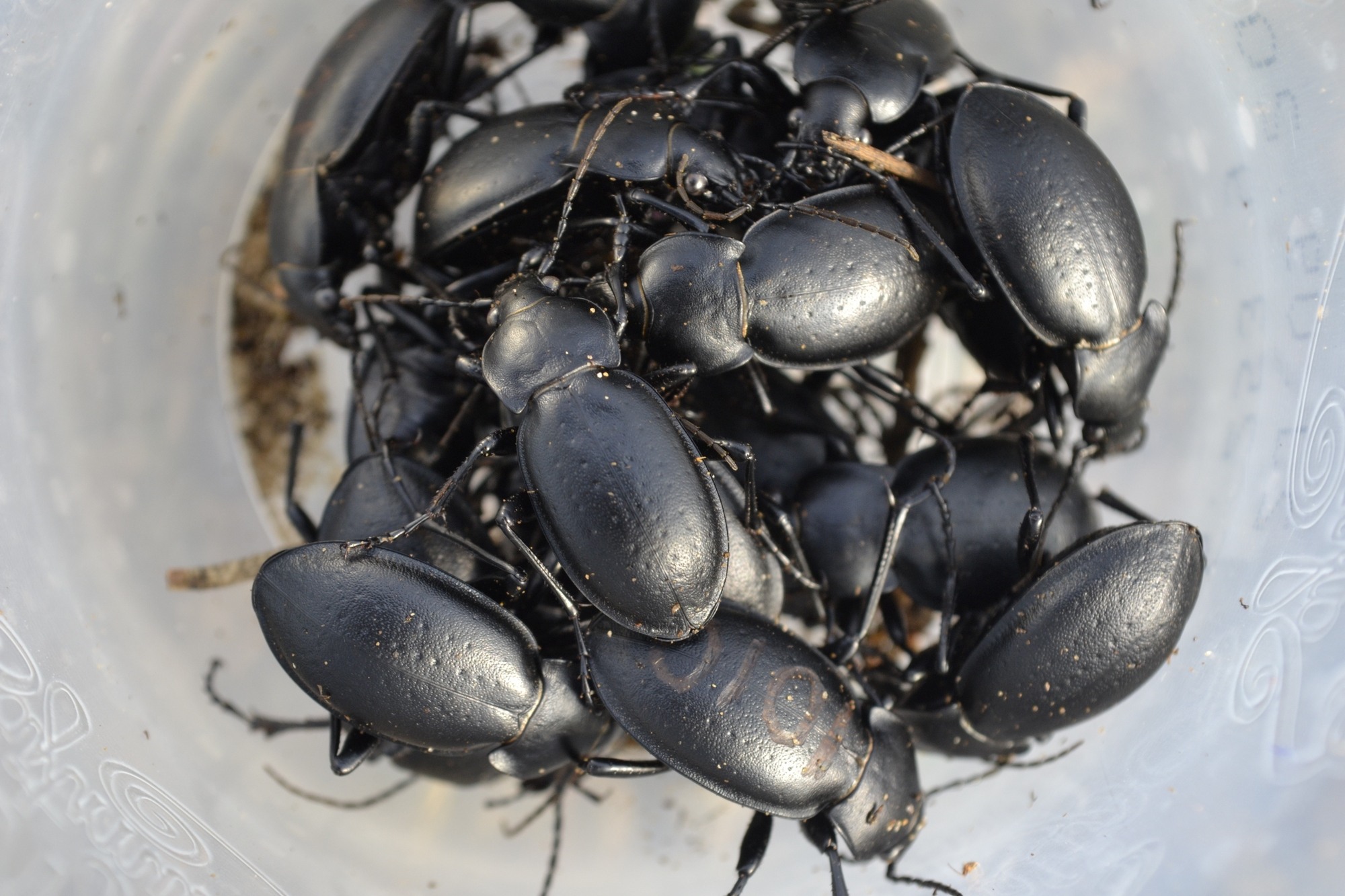
Yes, this is a pitfall trap full of Carabus hungaricus.
What kind of beetle is this, which is the greatest desire of our researcher? It is a 20-30 mm long, black ground beetle with a slight greasy light, which has 3-3 lines of potholes running through its elytron. It is especially a resident of open and closed sand steppes; it is active at night, but in late summer and on sunny autumn days it moves during daytime as well.
In our country, it is a specially protected species; it has a theoretical value of 100,000 forints. The continuous destruction of its habitat, unfortunately, leads to a significant decline in its stock: this danger lurks especially in the agglomeration of Budapest and near the settlements of the Little and the Great Hungarian Plain.
In the autumn of 2013, the experts of Danube-Ipoly National Park launched a large-scale research in the territory of the Military Shooting and Training Range of Táborfalva, where Carabus hungaricus still has a strong and large population. Within the framework of this research, we labelled each and every Carabus hungaricus that fell into the pitfall trap by engraving an identification number onto their elytron, and then we set the beetles free. This method does not harm the insects; however, with the help of the numbered beetles caught again, we can get hold of such important information, like the size of the population, how long do they live, or what distance do these insects take. This knowledge is essential for the planning of the protection of the species as well.
The majority of the Carabus hungaricus has by now hibernated for winter, so we can report that by the end of October 2014, 1400 of its specimens have already been labelled within the framework of the research.
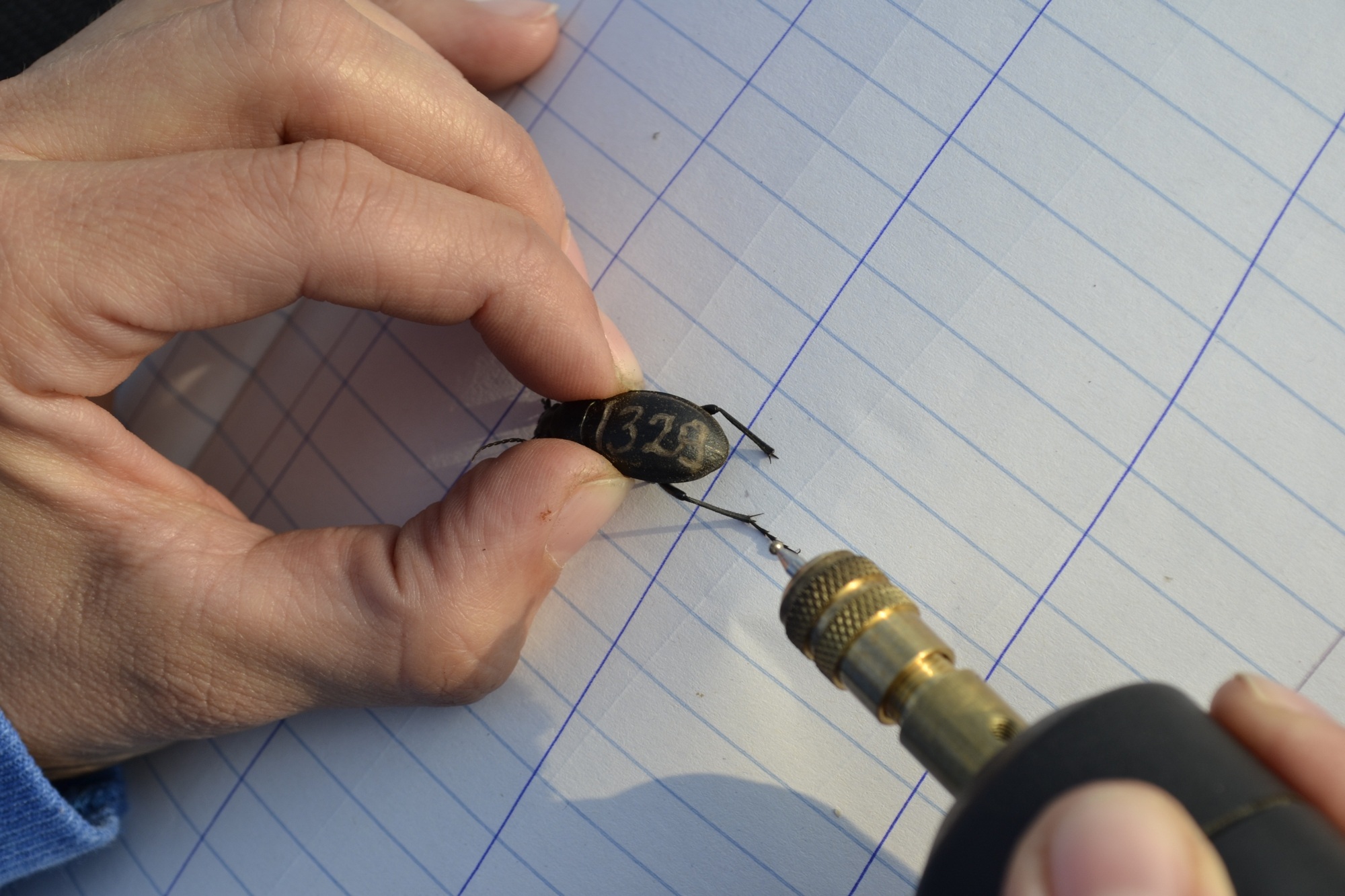
Photos: György Verő
31 July 2014 - Klára Kerpely
Outdoor day in Turjános of Dabas Nature Reserve
On the outdoor day we collected data of the protected plant species occurring in the nature reserve, which is situated in the neighbourhood of the military shooting range in the edge of Dabas. Annamária Csóka, a colleague of DINPD led us with two other volunteers and managed our work.
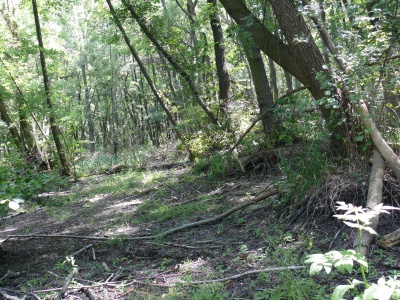
Fen forest (Mónika Vacsora)
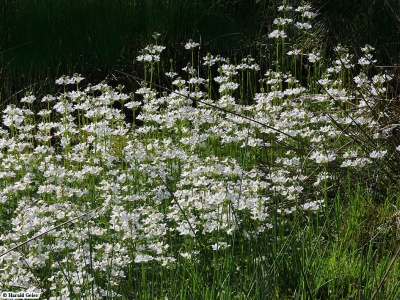
Water violets (http://carpathianbasinspecies.eu)
First, we visited the fen forest that was not covered with water in this season, in the end of July, it was dried up. Here, in the ground surface we found a massive presence of water violets (Hottonia palustris) that had ceased flowering.
We defined the exact location of the plants by GPS and these data will be added to the existing database. We collected data in the following way: if there were too many plants at the same place, we estimated the number of the stocks and put a spot in the center of the group with the GPS. If there were countable number of plants at the same place, we took coordinates of each individual one by one.
Leaving the forest we continued the work in an open, mown meadow. There were uncut strips in the meadow at different distances from each other, and we found more protected plant species there such as Pannonian knapweed (Centaurea sadleriana) and Cirsium brachycephalum which is a Natura 2000 species.
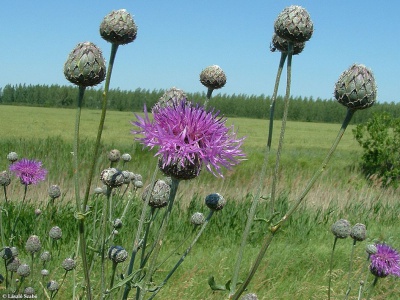
Centaurea sadleriana (http://carpathianbasinspecies.eu)
Pannonian knapweed is a subendemic species of the Carpathian Basin, it prefers loess-sandy soil. Its name comes from the name of József Sadler. This species is not endangered but it was necessary to declare it protected because of its small habitat (it occurs only in Hungary and the border areas of it).
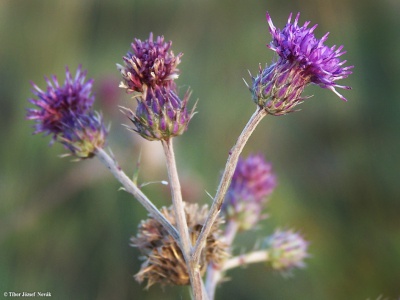
Cirsium brachycephalum (http://carpathianbasinspecies.eu)
It is a halophyte species that is native in the Pannonian Basin. This thorny plant prefers the wet, moist habitats, the most threatening factor of it is the disappearance of wetlands.
We saw more groups of long-leaf speedwells (Pseudolysimachion longifolium) in the edge of the forest.
In the mown parts, next to the uncut strips Blackstonia acuminata and dwarf everlast (Helichrysum arenarium) could be found. It is an annual plant and has a vivid yellow flower, which occurs mainly in marsh meadows, fens and salines.
Dwarf everlast is a herb that is used in the treatment of gall bladder disorders and indigestion owing to its antispasmodic effect and it has antiinflammatory and antiseptic properties, too.
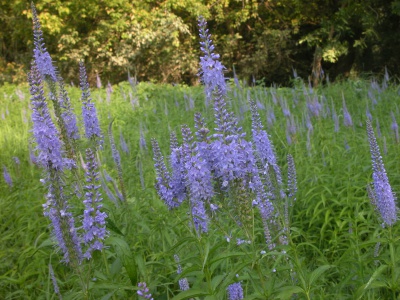
Long-leaf speedwells (Mónika Vacsora)
Of protected animal species we met a European green lizard (Lacerta viridis). This is the biggest species of lizard in our country, its body length can be even 40 cm. The mouth and the throat of males became blue in mating season. Its favourite type of habitat is a hillside spotted with trees or bushes. This animal is a predator, it feeds on mainly arthropods but preys smaller nestlings and rodents, too. When it is threatened it opens its mouth totally and makes a snorting, hissing noise like cats, before the attack. It has a theoretical value of 25000 Ft.
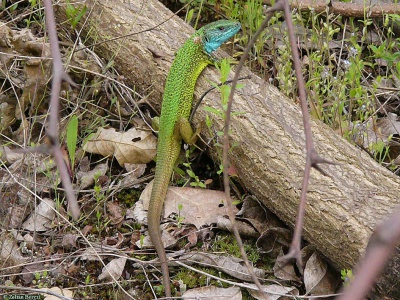
Green lizard (http://carpathianbasinspecies.eu)
Mónika Vacsora
Intern, WWF
18 July 2014 - Annamária Csóka
Visit of the representative of the external monitoring team
Our project was visited on 16th and 17th of July by the representative of the Astrale-GEIE external project monitoring team, András Kovács.
On the first day, the project team gathered in the centre of Danube-Ipoly National Park Directorate. Here, the results of the Turjánvidék LIFE+ program were presented in a lecture by the partners responsible for the project, and we also reported on the application’s administrative and financial progress.
On the second day, we visited the increasing number of sites of conservation treatments, starting from the Táborfalva Military Base. Thus, just beyond the half-time of the application, we could already boast with the fulfilled tasks at 9 stations.
Photo: Annamária Csóka
30 June 2014 - László Gálhidy
Forests’ naturalness examined in shooting ground
We could think that on a shooting ground there must be natural stands of forests – as far as the special use of the area makes its survival possible. However, this is not the case; forestry and plantation also exists here in the shooting ground of Táborfalva. The original vegetation underwent a significant change, even damage in our project site, in an almost 29 square mile large and diverse area in the middle of the Great Hungarian Plain. Besides, new plantations of trees that are not indigenous here were created, too. With the help of forest naturalness examination, we can get a picture of how much the forest resembles, or rather, how much it differs from its original form. The main aim is to show how much the forest plantations and the spreading of invasive wood species changed the image of the landscape near to Dabas and Táborfalva.
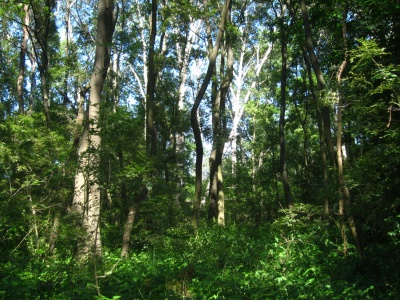
What is an expert looking for when making such an examination? What qualities of the forest are they most curious about? No wonder that biodiversity is one of the first aspects; in the layer of the canopy as well as in the level of the ground. No less importance has to be given to the amount and to the pattern of the species, the amount of dead wood, the degree of game damage and the extent of the effects of erosion. Many questions cannot be answered so easily, so a datasheet helps the work with its questions and answers of multiple choice.
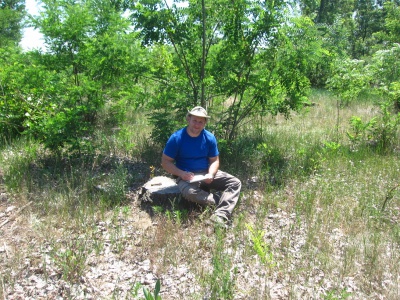
We attended three different places. We started our work in two dry sorts of forests, which were originally a sand dune thicket with juniper and poplar. Heading in the forest was easy, for the plantation which was planted instead of the original forest had only a few bushes, so it was easy to go and see through. The third forest – a dark ash forest – had in fact a very thick blackberry brambly as an undergrowth. Getting an overall picture about the compound of the forest was only possible by tumbling, collecting spider webs and by-passing thorns here. Fortunately it was not raining. We filled the datasheet in every spots, which draws the momentary picture of the quality of the examined forest. We found a big number of not indigenous species of trees especially in the dry areas in Táborfalva. On the other hand, old trees, dead woods and indigenous species were barely presented there. This examination also confirmed the importance and justice of the rehabilitation of the habitat, which was taken in this project.
After finishing our work, we took a look to the huge mulberry tree in one corner of the shooting ground. It throws its fruits over and over – and no one harvests them…
A curiosity of this day was that we met an expert in research of insects. He discovered an exceedingly rare sort of bug in the sand grass. The osimus ammophilus is an ordinary, medium size, black colour species of bugs, and still it makes colleagues happy when they find more and more of them. This bug is an inhabitant in dry areas from Turkmenistan to the Mediterranean Sea, but in Middle Europe it can be only found at some given points of Hungary. It is highly possible that its survival in the nearby areas of Táborfalva is – among others – due to the presence of the shooting ground.
Photo: Annamária Csóka, László Gálhidy
30 May 2014 - Klára Kerpely
WWF workday on the field
In the end of May the team of WWF Hungary organized an outdoor workday. It is very rare that all of our colleagues are given the chance to taste the fruits of our labours on the field. This time we visited Military Shooting and Training Range of Táborfalva, the location of our Life project. The team of WWF took part in the mapping of the natural values of the shooting range; we took a survey of the stock of four protected species of plants in the sandy habitats of the training ground.
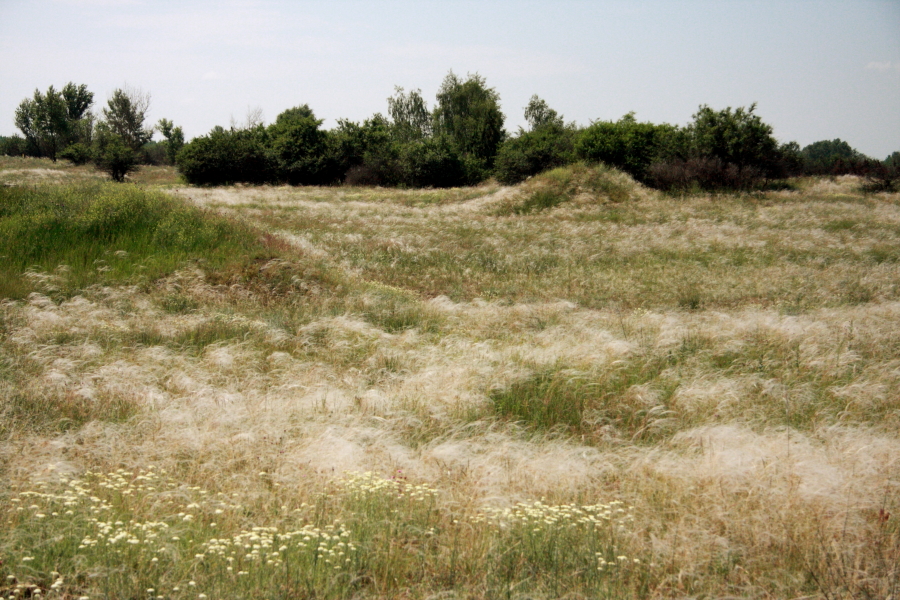
Achillea ochroleuca, stipa borysthenica, alkanna tinctoria and ephedra distachya are protected species and are of great ecological value. Our colleagues ranged the area in pairs, searching for the presence of certain plant species. They noted the GPS coordinates of every single occurrence and estimated the number of the stocks. Data will be added to the database of Danube-Ipoly National Park Directorate and can be of help to the revision of the management plan of the area.
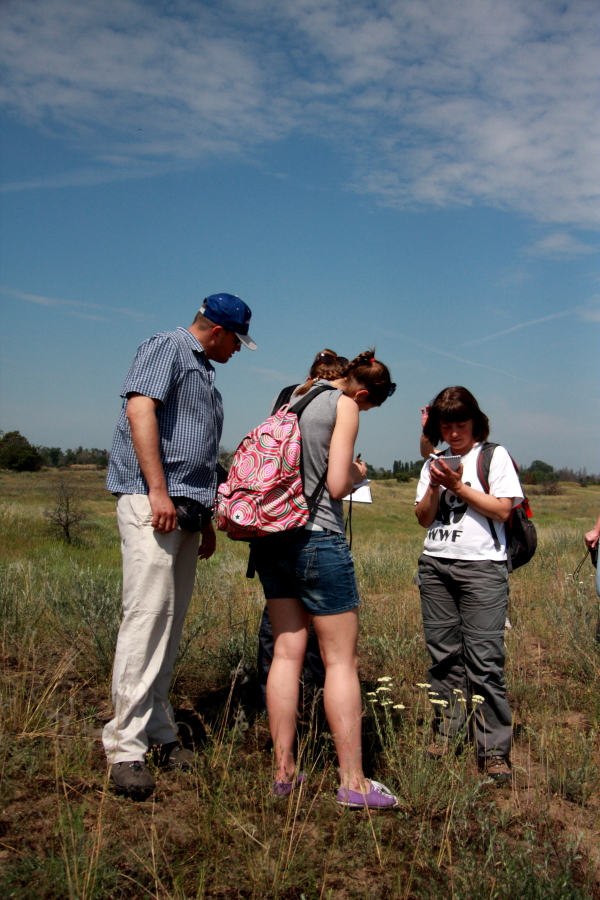
In the afternoon our group got to know the most endangered species of the area, the meadow viper. This rare species of snakes is hardly found in the wild in this time of the year, therefore we visited the Hungarian Meadow Viper Conservation Centre run by Birdlife Hungary. In a farm near Kunpeszér Tamás Péchy demonstrated this extremely vulnerable little animal and the outcomes of their steadfast labours pursuing for survival.
Photo: Anastasiya Timoshyna
5 May 2014 - Klára Kerpely
Day of the Earth game about Turjánvidék
On 22 April, the Day of the Earth we celebrated with the Facebook followers of WWF with a quiz game presenting Turjánvidék. Questions followed each other during four days and we drew presents among the ones who answered correctly.
Facebookers showing an interest could come to know that the expression “turjános” indicates a soggy, waterlogged impracticable vegetation and that a country like this makes a home for many species of reptiles which are under protection, since all the species of reptiles and amphibians are protected in our country.
Our winners drawn out of the more than hundred correct guessers:
Gyula from Székesfehérvár
Anett from Baktakék
Erzsébet from Gávavencsellő
Evelyn from Budapest
We will post them Turjánvidék LIFE presents.
Thank you for the participation! Let’s have every day the Day of the Earth!
27 March 2014 - Annamária Csóka
Let’s become a lichenologist!
How is the division of labour in the household of lichens? Why are lichens outcasts of the flora? Do they have scent? What is the mapping of lichens?
You can get the answer to these and many other interesting questions by reading the recently published 12th volume of the series of “Cincér” booklets about educational trails, the Pálfája Lichen Trail booklet, which is entirely the work of the lichen expert Lóránt Kácsor. The real surprise, however, is waiting for those who set out on a trip with this brochure in their hands. Since lichens can be found in almost every natural and semi-natural habitat, the booklet can be a great help in other areas, like the educational trail of Betyár Hill in Táborfalva, too. Do not forget: lichens are in “bloom” in wintertime as well.
The Pálfája Lichen Trail Booklet is available through the following link:
http://www.pusztaitolgyesek.hu/index.php?page=tanosveny
We wish you a nice trip!
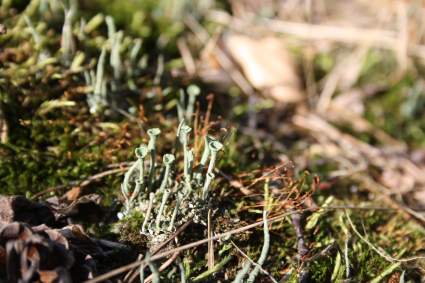
Photo: Lóránt Kácsor
7 February 2014 - Annamária Csóka
New project year started
On February 16, 2014, despite the extreme weather conditions, our project staff was gathering cheerfully at an irregular conference location, at the the Danube-Ipoly National Park Directorate’s Sas-hegy visitor centre. Our meeting was held in the panorama hall, from where there is a stunning view of precious habitats of Sas-hegy Nature Reserve in Buda and the surrounding capital.
While it was sleeting outside, our partners were displaying in the framework of spectacular presentations the several results already achieved by Turjánvidék LIFE+ tender. Our next great task was to finalise the work schedule of the year 2014.
With this meeting our new project year officially began.
Photo: György Verő
20 December 2013 – Annamária Csóka
Season's Greetings from Turjánvidék!
28 October 2013 - Annamária Csóka
We closed our seminar titled „Nature conservation treatment of aggressive invasive species in practice” with success
In many readers can raise up the question immediately: „What are aggressive invasive species?” They are not indigenous (alien) species that spread fast and pose a serious threat to the natural habitats. Everybody has already met several representatives of them: such as ailanthus, box elder maple, common milkweed or Canadian goldenrod.
Almost 100 representatives of national park directorates, forestry companies, professional institutions and enterprises dealing with plant protection gathered together to share their abundant practical experiences in the topic of invasive plant control on 14-15 October, in the Forster Hunting Lodge in the settlement Bugyi.
On the first day of the seminar participants reported on their activities and experience in the form of short lectures. On the second day of the professional programme we visited the interventions carried out successfully on invasive plant management in the target area of our LIFE project, taking place in Military Shooting Range of Táborfalva and in Csévharaszt juniper forest nature conservation area.
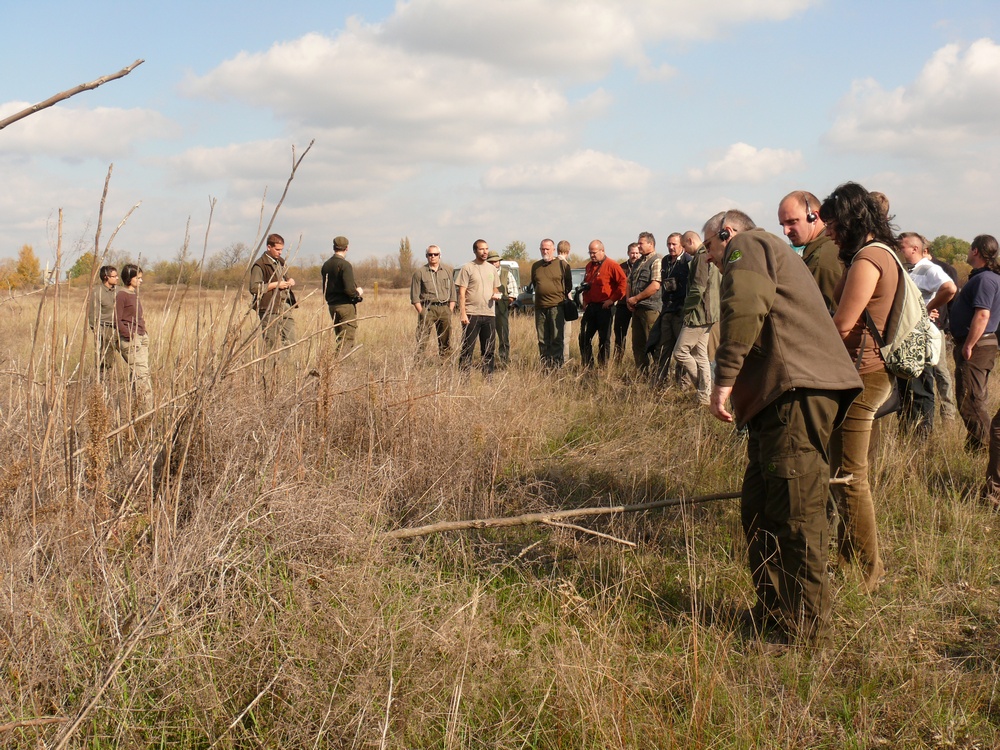
The seminar, which was surrounded by great interest, was organised within the framework of a LIFE+ Nature project titled „Conservation of priority natural values in Turjánvidék Natura 2000 site southern unit” and a project of the Hungary-Slovakia Cross-border Co-operation Programme, „Standardized protection against invasive species in sand and floodplain habitats”.
16 September 2013 - Annamária Csóka
Study Tour in Slovakia
On 10 September 2013, participants of our project went on a study tour in Slovakia. Our destination was Zahorie, a military area, which is the location of a successful LIFE project implemented between 2006 and 2011. The weather was grateful: the sun was shining brightly so we could admire the Carpathians in the background of the landscape.
Jaromir Síbl was guiding us on our trip, who was a representative of the Regional Nature Conservation Society of Bratislava (BROZ), which is one of the organisations taking part in the project. On the three units of the military area that belong to the Natura 2000 network we viewed the targeted habitats, species and the results of the project.
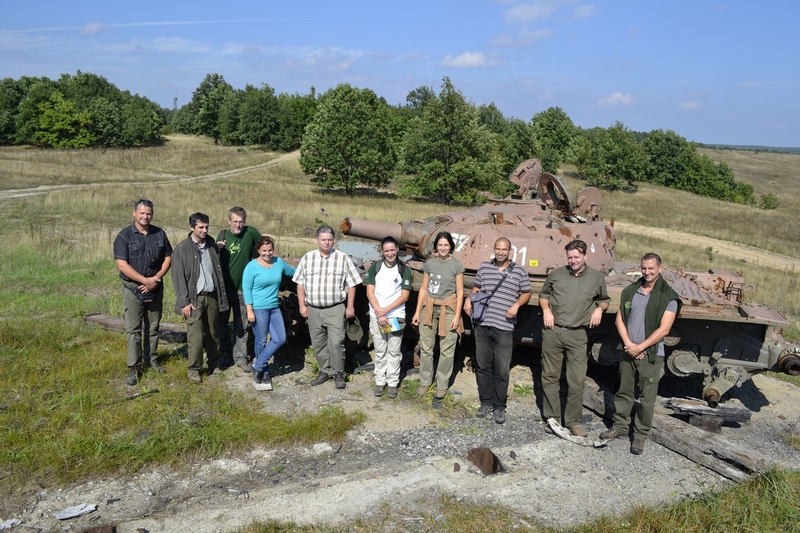
The Slovak project resembles to ours in two aspects: on one hand, it was realised in a military area; on the other hand, sandy habitats occur here also. The main aim of the project is the reconstruction of sandy grasslands with heath communities and habitats of forest steppe character, in addition to the increase of the cooperation between nature conservation and military users.
At the end of our journey, we happened to see some blooming garland flower, which normally blossom only in May.
12 August 2013 - Klára Kerpely
Nature Conservation Treatment of Aggressive Invasive Species in Practice Seminar
On 14-15 October 2013 Duna-Ipoly National Park Directorate and WWF Hungary organises a technical seminar, titled Nature Conservation Treatment of Aggressive Invasive Species in Practice. The event is part of the “Conservation of priority natural values in Turjánvidék Natura 2000 site southern unit” LIFE+ Nature project (LIFE10NAT/HU/000020) and „Standardized protection against invasive species in sand and floodplain habitats” Hungary-Slovakia Cross-Border Cooperation Programme (HUSK/1101/2.2.1/0052).
The objective of the seminar is to share and discuss with experts the huge amount of experience that has been accumulated in this field within the national park directorates, forestry companies, professional institutions and specialized enterprises. We would like to enhance the widespread utilization of this experience in practical nature conservation.
For information contact: Klára Kerpely, WWF Hungary, 30-233-7368, klara.kerpely@wwf.hu
25 July 2013 - Annamária Csóka
Landscape after battle
We need to report a sorrowful event: the sandy habitats of the Military Shooting Range of Táborfalva have been set on fire during a military exercise by a smoke candle on 15th July. The fire lasted until 20th July by renewing and breaking out on an other area as well. Mainly the Pannonic inland sand dune thickets, the Pannonic sand steppes and the drying-up fens became victims of the fire destruction on a total of 300 hectares on the project area. The fires that have been facilitated by sustained drought and strong winds have been curbed by the field specialist of the Danube-Ipoly National Park Directorate (DINPI), civil helpers, fire brigades from nearby settlements and various military units after a tough fight. The detailed survey of the caused natural damages is being carried out currently. We already know, that the major damage has occured on the protected, highly protected and Natura 2000 flora and fauna of the sand steppes. The habitat regeneration will take up decades. It may take up 100 years to gain the original state on the inland sand dune thickets. The devastation on these burned down areas is giving us a new objective: to fight back the imminent and intense spread of the invasive plants, which is not going to be an easy task.
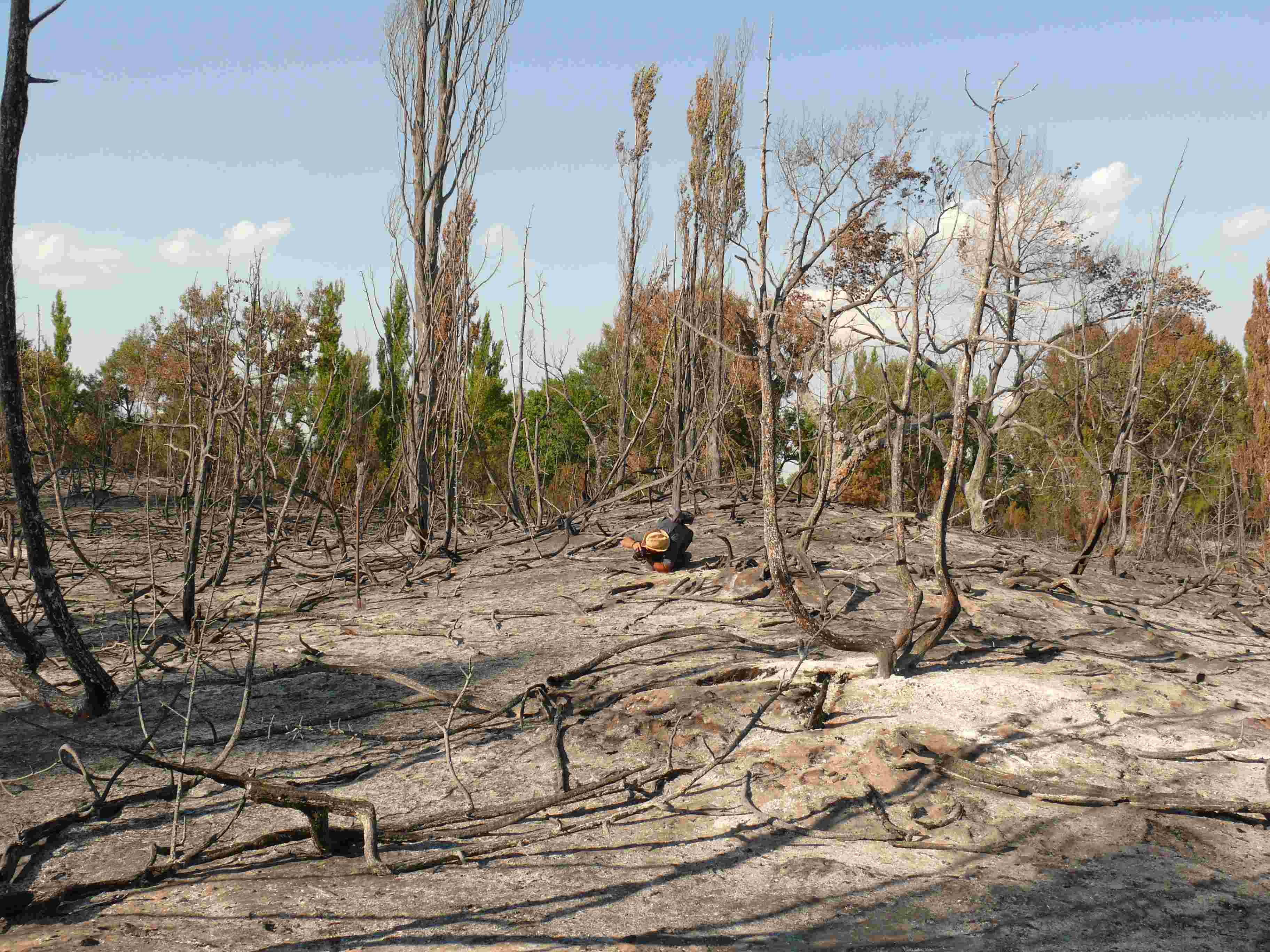
25 June 2013 - Klára Kerpely
Press tour in Turjánvidék
On 20th June, a news conference for the media was organised about our Turjánvidék LIFE project. Despite the great heat, a lot of visitors arrived for the tour: nearly 30 press associates and several representatives of our partners participating in the programme.
The programme was held on the Military Shooting and Training Range of Táborfalva and the Turjános Nature Reserve of Dabas with the cooperation of the Danube-Ipoly National Park Directorate, the project partners and the workers of the military area.
At the beginning, Lieutenant Colonel János Vokla and Katalin Sipos, deputy-director of Danube-Ipoly National Park Directorate (DINPI), greeted the visitors. Then Annamária Csóka, project manager, held a presentation about the natural values of the area, as well as the aim and activities of the LIFE project. Of course, at the end of the presentation, representatives of the media could ask from the partners of the project.
After the presentation, the group set out for the tour, equipped with refreshments and cameras. We started our journey by a huge PTS amphibious vehicle, and then changed to land rovers.
From time to time, we interrupted the tour to get acquainted with the peculiarities, arrangements and functions of the shooting range by the leadership of Major Bártfai. György Verő, field representative of DINPI, held a presentation about the characteristic habitats of the area and the Hungarian meadow viper. Many of us tried to find a specimen of this species; however, we only came across with its main food, the Hungarian tarsza, which is an endemic species that belongs to the order of orthoptera, or a specimen of a very similar species. Unfortunately, for obvious reasons, the group was able to observe the fen forests only from a distance to avoid the disturbance of the habitat rich in specially protected species.
We arrived back to the point of departure wearily after an almost three-hour trip, where we were waited with delicious goulash made of Hungarian grey cattle, and some strudel.
With so many eager questions, we believe that the participants enjoyed the programme despite the heat.
We hope that a lot of reports will be made about our project for the protection of Turjánvidék, since there was no shortage of interviews, and we are confident that this way even more people all across the country will get acquainted with our effort based on broad cooperation.
5 May 2013 - Annamária Csóka
The external project monitoring team visited us again
On the assignment of the European Commission the external project control committee of Astrale-GEIE visited our project for the second time on the 29th and 30th of April, 2013. The external LIFE monitor of our project is now Hungarian – András Kovács – so no language barriers could halt the conversation. We were honoured by the presence of Mr. Bent Jepsen as well, who is the member of the central leading team of Astrale-GEIE, he came all the way from Brussels.
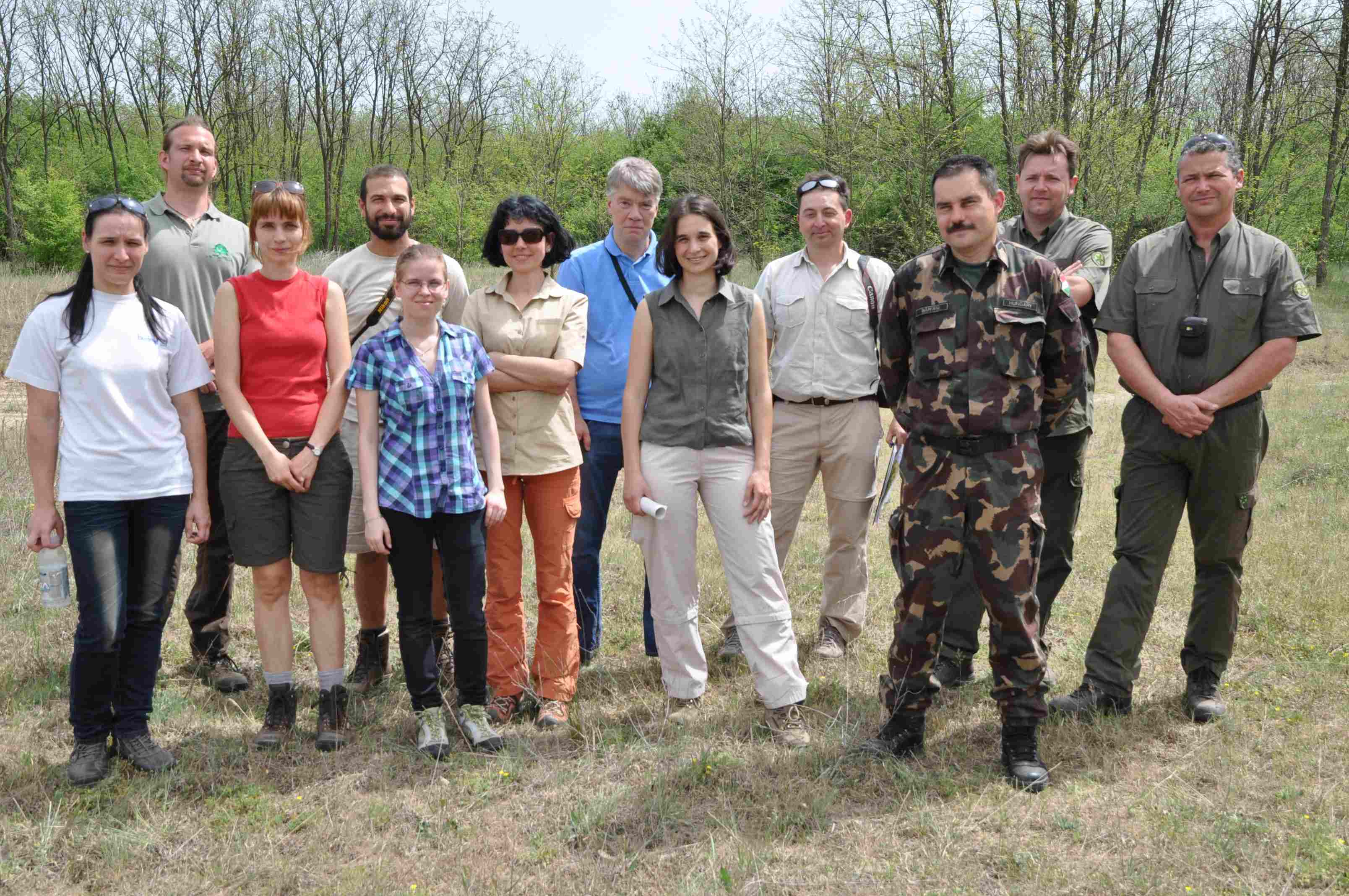
On the first day we presented the technical, administrative and financial developments of the Turjánvidék LIFE+ project in the Budapest office of the Duna-Ipoly National Park Directorate. The second day was spent entirely on the project area to see the results that were already achieved. A little time was spared to visit the Táborfalva Military Base.
Our monitors were satisfied with the results and wished us further successes.
10 April 2013 - Annamária Csóka
Our meadow viper research has started with great results!
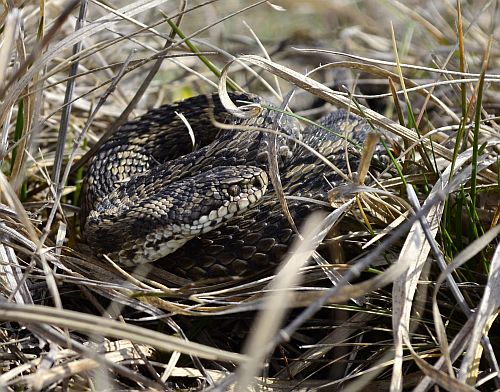
We started our search with high hopes and in favourable weather conditions to find out the size of the Hungarian meadow viper (Vipera ursinii rakosiensis) population in its habitat near Dabas. Our efforts soon yielded results: we encountered a beautiful 3-4 year old male! Due to the prolonged winter, this cold-blooded animal must have been very grateful for some sunbathing!
The Hungarian meadow viper is a very cautious animal, one can hardly see them in the wild. The best chance to have a glimpse at them is this time of the year, when they are preparing for mating hence move about more. We were sure that this rare reptile lives here, but a living specimen was last seen in 2009.
The Hungarian meadow viper is the only endemic vertebrate subspecies in Hungary and one of the most threatened reptiles of Europe. Its range used to be much bigger, now it only lives in the Duna-Tisza Interfluve Region (the region between the Danube and the Theiss), in the Hanság and in Transylvania. The estimated world population is 500 specimens. It is strictly protected with a conservation value of 1 million HUF. Adults barely reach 50 cm. It is a venomous snake but it hardly ever bites, the venom is not dangerous, rather similar to a bee sting.
The Hungarian meadow viper occurs on grasslands formed by a mosaic of wet and dry meadows as this habitat provides suitable microclimates and microreliefs. The young animals feed on Orthopterans (grasshoppers, locusts, crickets), adults prey on lizards, chicks and rodent pups as well. This rare reptile hides and hibernates in rodent burrows and on combs.
The main reason of their decline is habitat loss and cultivation of the remaining grasslands but intentional demolition and illegal collection also contributed to the tragic decline of this species.
In the 1990s the above mentioned grassland near Dabas was the stronghold of the Hungarian meadow snake population. As a small population is always very vulnerable, the accumulative negative effects on the habitat caused the collapse of this population.
In the Turjánvidék LIFE+ project we will shortly introduce extensive grazing regimes on the area which will create a more suitable habitat for the Hungarian meadow snake.
15 December 2012 - György Verő
Winter has come to Turjánvidék: the waxwings have appeared
Winter has suddenly descended after a long, mild autumn which had finally brought some rain. Precipitation has turned to snow with the reduction in temperature. For people living in this area, although more monotonous and mellow, winter is as beautiful as the colourful autumn. But for all other creatures, surviving winter is one of the hardest challenges of all. Plants go into dormancy and use different strategies to survive winter: trees will blossom from the buds at the end of their sprouts in the spring, many herbaceous plants bloom from their underground structures, and annual plants survive as seeds. Animals' survival strategies are determined by two factors: the adjustability of their body temperatures and the winter availability of food. Birds' feathers are amazing insulators, so only those species migrate which do not find food in the winter. These are mainly the ones eating flying insects (e.g. swallows) or eating amphibians or reptiles, which hibernate in the winter due to their variable body temperatures (e.g. storks or snake-eagles). Birds migrating from here in the winter are replaced by those spending the winter in Hungary, or the species hatching here will be amended by winter guests. These months see many more buzzards in the roadside trees, and the fields are visited by huge teams of crows. Typical winter guest is the colourful bullfinch, the size of a sparrow, sitting on top of trees. The lucky among us may spot their bright red males. Fieldfares take off from the scrubs which are heavy with their autumn fruits. Certain species, however, seldom show themselves in greater numbers in the winter months. Such is the Bohemian waxwing, nesting in far away northern pine forests, only appearing in large numbers on every fourth winter. Several sightings indicate that this year is also a “waxwing-year”. The Turjánvidék Natura 2000 area is no exception to this: we have sighted this species with their characteristic feathers, flocking together.
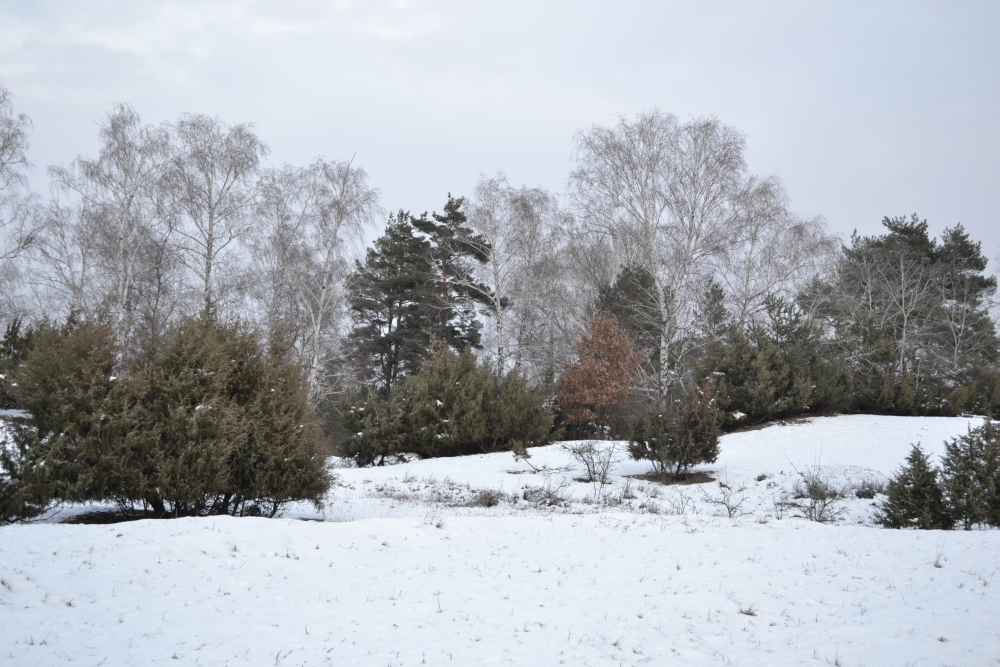
We wish our readers a Merry Christmas and a successful new year with this beautiful winter photo of Turjánvidék.
2 October 2012 - Annamária Csóka
Sand saffron is in blossom on our project area
Sand saffron (Colchicum arenaria) is in full blossom on the sand dunes of the Táborfalva shooting range. The petals of this species are much smaller than those of the more frequent Autumns crocus, and their living areas also differ: sand saffron usually lives in forest steppes. It is a highly protected Natura 2000 species of community interest, with a monetary value of 100 000 HUF per specimen. The colour of its flower may vary from pale pink to purple red, but this Autumn our camera lens captured an “albino” specimen!
This bulbous plant opens its petals in September and October, at this time only its flower surfaces. Its leaves and fruit appear the next spring. It is highly poisonous as the chemical inside blocks cell division. Due to its dangerous nature it is no longer used in medicine, but is still very handy for cancer research. Saffron's latin name is also connected to its poisonous nature: in the ancient history, Medeia, the famous witch living in Colchis' kingdom, used this plant frequently when preparing her magical potions. In folk traditions, this plant is also named as 'dog-killer'. Grazing animals steer well clear of it.
Colleagues at the Danube - Ipoly National Park Directorate use GPS to record the locations of sand saffron plants, in order to track changes in the size of its stock. This may also help us preserve this rare plant species from endangering factors.
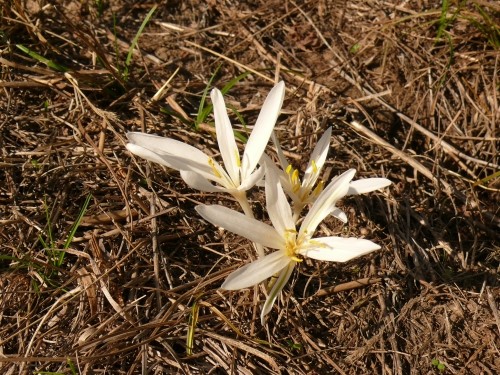
24 September 2012 - Annamária Csóka
Our trip in Eastern Bakony
On 20 September 2012 we visited the Várpalota shooting range, the Eastern Bakony area of the LIFE+ programme. Similarly to that of the Táborfalva shooting range, this military area also has a long history: established in 1913, it is the largest active shooting area of Hungary of 13000 hectares, which is also home to such outstanding natural jewels as the country's largest dolomite rocky grassland and traces of precious rocky and thermophile forests.
Project managers of the grant programme are organisations identical or similar to ours: Ministry of Defence Arnament and Quartermaster Office; HM Forestry Veszprém; the Balaton-felvidéki National Park Directorate; and Aquaprofit Co.
The weather was kind to us, as it was windy but sunny instead of the forecast rain when the professional and enthusiastic Bakony project team presented several results of the nature conservation programme, which started in 2007. Among the achievements were removing invasive plants, changing pine plantations back to the autochthon forests, fencing game off, re-cultivation of abandoned military objects and mines, reparation of roads, and improving the efficiency of firefighting to save such species as the serratula lycopifolia, the saker, or several rare bat species. Strengthening cooperation with military users of the area and communication are key elements of this programme as well. With many bright ideas gained from this exchange of experiences, we retreated to Turjánvidék, our own project area.
More information can be found on the Eastern Bakony LIFE+ programme on www.keletibakony.hu
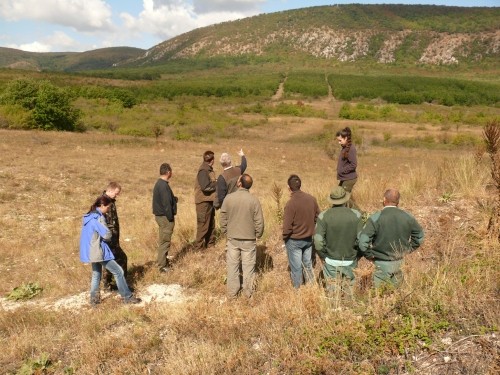
27 June 2012 - Annamária Csóka
We met the Hungarian meadow vipers
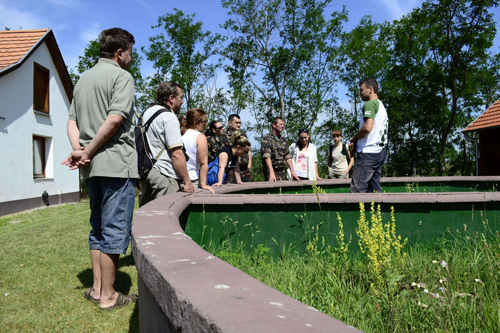
On 27 June 2012 our colleagues working on the project visited the meadow viper conservation centre. The Hungarian meadow viper is an extremely rare and endangered reptile, and also a real “hungaricum”: this is the only vertebrate subspecies that only occurs in Hungary. In the centre, which is located in the vicinity of the village of Kunadacs, we were guided by Bálint Halpern, leader of the meadow viper LIFE programme. He told us about the main goal of their work, which is to give shelter to individuals collected from locations under threat, and to include them in the reproduction programme. Today there are over 600 vipers in the centre, which is more than the estimated total number of individuals in the wild. Raising these snakes in captivity made it possible to clarify a number of scientific questions, whereas the great number of offspring enables the launch of their reintroduction into their original habitats from where they disappeared due to intensive agriculture. It was a very special experience to closely observe the “aristocrat of snakes”.
The Turjánvidék LIFE + programme is being run in an area that is home to the Hungarian meadow viper, so we could even encounter them in the wild, but unfortunately the chances of that are minuscule.
The habitat management actions of our project aim to improve life conditions of the meadow viper in the wild. We hope that this rare snake species will soon be able to recolonize its former distribution range.
The meadow viper centre is open to the interested all year round; however, it can only be visited under guidance. Contact person: Erzsébet Herbót (phone: +36 20 314 3192; e-mail: herbot.erzsebet@mme.hu). You may learn more of the species and the conservation programme here: www.rakosivipera.hu
21 June 2012 - Annamária Csóka
Remnants of ammunition on the project site
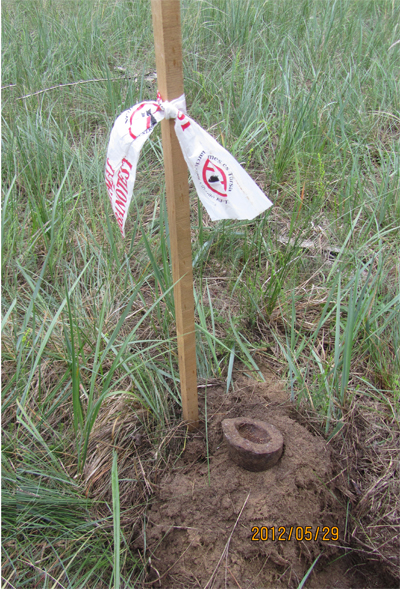
Within the frames of the project the preparation of the ammunition removal plan has been launched for the Táborfalva shooting range and military exercise area. The plan focuses on those areas where habitat management will affect the ground, i.e. about 50 ha. During field assessments the special detector indicated the presence of ammunition almost everywhere. Even unexploded grenades had been found in the area, which calls for special precautions of the personnel. The ammunition removal plan also aims to process historical documents on all kinds of activities in the area stored in museums and archives, contributing this way to the better knowledge of local history.
So please remember that entering the military area without the necessary permit is not only illegal, but also life threatening!
17 June 2012 - Annamária Csóka
New protected plant species discovered in the project area
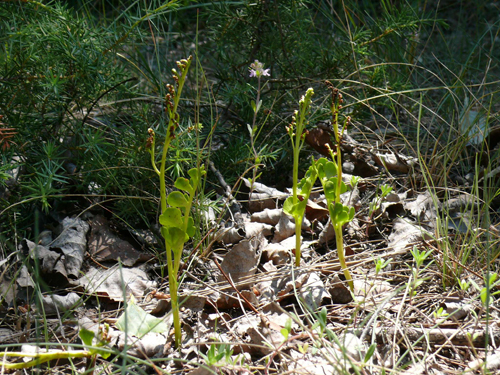
On 17 June 2012 while controlling the project area we got nicely surprised: in one of the poplar-juniper patches of the Táborfalva shooting range we discovered a population of common moonwort (Botrychium lunaria) consisting of 70 individuals. The species had never been recorded in the southern part of the Turjánvidék Natura 2000 area. The common moonwort is a member of the adder's tongue family (Ophioglossaceae), and belongs to the primordial ferns (Primofilices). It is a perennial plant difficult to notice, with a height of 3-35 cm. Each year only one leaf grows out of its rhizome, which then divides into a green part and a sporophyte that becomes brown over time. This species usually occurs in mountain meadows, it is a real rarity in the Great Hungarian Plain!
3 May 2012 - Annamária Csóka
Visit of the external monitoring team of the European Commission
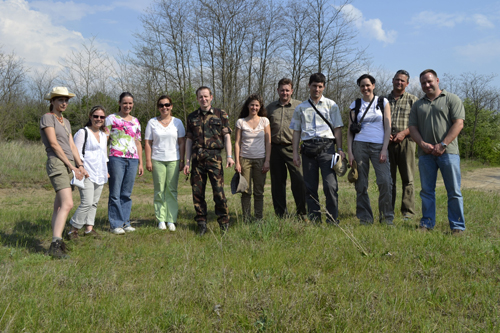
On 3 May 2012 the representative of the European Commission examined the implementation of the Turjánvidék LIFE+ project for the first time. Member of the external monitoring team Astrale-GEIE, Mr. Andrej Bača checked the technical, administrative and financial aspects of project implementation. All project partners were represented during the visit. At first administrative documents of the project were presented at the centre of the Danube-Ipoly National Park Directorate in Buda, then we visited and walked around the project area, which shows its most beautiful aspect at this time of year. As a foreigner, Mr. Bača was glad to see this steppe-like habitat, which can not be found further west of Hungary. He was satisfied with the progress of the project and wished us successful work for the future.
21 April 2012 - Annamária Csóka
Examination of the natural state of forests in the project area
In spring this year the Danube-Ipoly National Park Directorate and WWF Hungary carried out a common field check-up on Hungary’s largest and oldest shooting range near Táborfalva. This slightly hilly landscape, which forms part of the Turjánvidék area to the south-east of the capital, harbours an ancient vegetation that was one characteristic to great parts of the Hungarian plains. Sandhills with poplars and junipers alternate with patches of steppe covered in feather grass.
As a first step to the natural state assessment of the forests of the area we examined a few forest patches and walked through all square meters of them. The aim of the assessment is to figure out how much different these patches are compared to a fully natural, undisturbed forest, i.e. whether there are any ancient trees, fallen old trees, whether the new tree generation is made up of indigenous species, and whether the soil is damaged. Results of the assessment will help to determine where and what kind of habitat management actions will be necessary in the future. During the field visit several really ancient individuals of poplars were found, as well as huge hawthorns, and we also got soaking wet of the rains. It could be concluded that in this area where no other human disturbance is present due to military operations the life of the forests is still formed by natural processes today.










